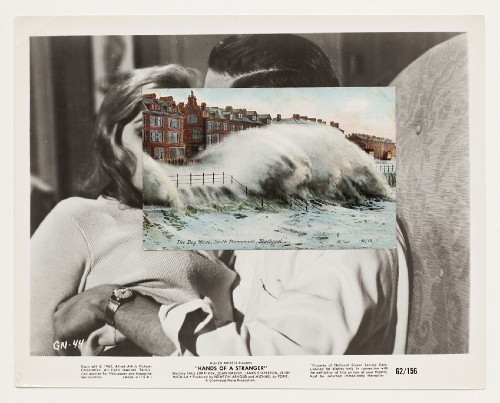John Stezaker
02 Mar - 07 Apr 2012
JOHN STEZAKER
2 March - 7 April, 2012
This is the second exhibition of John Stezaker at Galerie Gisela Capitain. In the new exhibition Stezaker shows a number of new Collages focusing on a recent use of images of water: waves, waterfalls, torrents.
Despite having read much on the subject of water symbolism (from religious practice through to its symbolism in Romantic literature) Stezaker is no nearer to understanding why water features in so much of his work.
But, as always in his work, he is interested in the overlap of the mythic and archetypal world onto the stereotypical and everyday world, in the way mythic themes and associations of water for example, spill over (to use another aqueous metaphor) into the circulatory movement of images. “As always I am interested in the truth of the stereotype“, Stezaker says.
Even though the images of waves, waterfalls and lakes have been around in Stezaker’s work over a long period, the reason that these images have started to take on a new association, is because of the discovery of a new image source. In around 2008-2009 Stezaker acquired a collection of publicity photographs of singers and singing groups from the 40’s and 50’s. The recent work is prompted from this coincidence between the image of the female singer and the wave or waterfall as in the ‘Siren’ and ‘Siren Song’ series. The femininity of the figure of the siren, like that of the muse is an image of the image itself – of its allure, seduction. It is what pulls one into the depths beyond the surface currents of experience, in a way that is parallel to the way that fascination takes the image out of its passing ephemeral circulation. Blanchot calls these ’arrests of time’ (an arrest that for him is a confrontation with death). Mythically, the siren sings the music of the deep whose flow arrests itself in death – eternal sleep. Whereas the muse of music is breath – inspiration, the breathing in of the siren’s song results in drowning. Abandonment to the song then means death in the inversion of air and water. The mythic association between the female, inundation, formlessness, and a yielding to chaos is an archetypal association.
Collage exists as a result of a tidal flotsam of images. Its fragments are left by the ebb of image circulation. The collection could be seen to represent a resistance to the formlessness of perpetual flow.
Inasmuch as the found image represents a withdrawal from flow, a seclusion of the image in a kind of stilling. But it still depends on a serial connection between images, whether this is in the collection of images or in the collage series. So rather than stilling you could say that the collage series are in themselves the eddy-currents of image circulation.
2 March - 7 April, 2012
This is the second exhibition of John Stezaker at Galerie Gisela Capitain. In the new exhibition Stezaker shows a number of new Collages focusing on a recent use of images of water: waves, waterfalls, torrents.
Despite having read much on the subject of water symbolism (from religious practice through to its symbolism in Romantic literature) Stezaker is no nearer to understanding why water features in so much of his work.
But, as always in his work, he is interested in the overlap of the mythic and archetypal world onto the stereotypical and everyday world, in the way mythic themes and associations of water for example, spill over (to use another aqueous metaphor) into the circulatory movement of images. “As always I am interested in the truth of the stereotype“, Stezaker says.
Even though the images of waves, waterfalls and lakes have been around in Stezaker’s work over a long period, the reason that these images have started to take on a new association, is because of the discovery of a new image source. In around 2008-2009 Stezaker acquired a collection of publicity photographs of singers and singing groups from the 40’s and 50’s. The recent work is prompted from this coincidence between the image of the female singer and the wave or waterfall as in the ‘Siren’ and ‘Siren Song’ series. The femininity of the figure of the siren, like that of the muse is an image of the image itself – of its allure, seduction. It is what pulls one into the depths beyond the surface currents of experience, in a way that is parallel to the way that fascination takes the image out of its passing ephemeral circulation. Blanchot calls these ’arrests of time’ (an arrest that for him is a confrontation with death). Mythically, the siren sings the music of the deep whose flow arrests itself in death – eternal sleep. Whereas the muse of music is breath – inspiration, the breathing in of the siren’s song results in drowning. Abandonment to the song then means death in the inversion of air and water. The mythic association between the female, inundation, formlessness, and a yielding to chaos is an archetypal association.
Collage exists as a result of a tidal flotsam of images. Its fragments are left by the ebb of image circulation. The collection could be seen to represent a resistance to the formlessness of perpetual flow.
Inasmuch as the found image represents a withdrawal from flow, a seclusion of the image in a kind of stilling. But it still depends on a serial connection between images, whether this is in the collection of images or in the collage series. So rather than stilling you could say that the collage series are in themselves the eddy-currents of image circulation.

